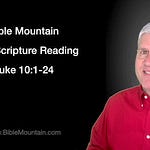Transcript:
There is a prevalent philosophy in today’s world, including within Christianity, that people should assume the best. If it appears that someone, particularly a leader, did something wrong, then this mentality means they should be given the benefit of the doubt. This mindset is applied, not only to religious leaders, but also to secular political and business leaders.
Furthermore, this viewpoint is not just espoused by people who have nothing to gain or lose. Sometimes a person who is accused of wrongdoing brushes aside the evidence of their misconduct and demands that his accusers assume the best. That should raise suspicions.
When Jesus was arrested and put on trial, the Jewish authorities did not have any evidence to convict Jesus. Instead, they had to make it up. This is proof that religious leaders can be corrupt and serves as a warning to us that our leaders, including religious leaders, might also be corrupt. Since they might be crooked, we should not assume the best.
From the time Jesus began healing people and performing other miracles, He faced opposition from the Jewish leaders. However, their questions and accusations did not stop Jesus. Even worse, from the viewpoint of the leaders, nothing they said restrained the crowd from following and adoring Jesus. Therefore, the leaders began seeking to destroy Him.
As early as the third chapter of Mark, we read in verse 6 that after Jesus healed a withered hand on the Sabbath, the Pharisees counseled with the Herodians about how to destroy Him. Mark 11 tells us that after Jesus threw the merchants out of the temple, the priests and scribes sought to destroy Him. Mark 14:1 uses the word “kill” to inform us of the intent of the priests and scribes. The leaders wanted to remove Jesus from the earth, but they knew Jesus was popular with the people. Therefore, they were constrained in what they could do.
Then we see in Mark 14:10 that Judas Iscariot, one of the twelve, went to the priests and offered to betray Jesus. The priests were glad because Judas was a member of Jesus’ inner circle. He was able to help them find and arrest Jesus at a time and place when there would be no crowd to interfere.
After Judas made his deal, Jesus ate the Passover with His disciples. Then Jesus went to the Mount of Olives. Jesus prayed in Gethsemane. When He was finished praying, Jesus announced to His disciples that His betrayer was at hand.
Mark 14:43 ¶ And immediately while He was still speaking, Judas, one of the twelve, came up, and with him was a crowd with swords and clubs, who were from the chief priests and the scribes and the elders.
Mark 14:44 Now he who was betraying Him had given them a signal, saying, “Whomever I kiss, He is the one; seize Him and lead Him away under guard.”
We are so used to living in the age of photography that we don’t grasp life without it. Today, when leaders send police to arrest someone, they can give the police a picture so the police know who to arrest. Because of television, the police already know what famous people look like.
The Jewish leaders were not able to do that. Jesus was famous, but since they didn’t have television, very few people knew what He actually looked like. They did not have a picture of Him. The only way they could find Him was to find the crowd that followed Him, but the presence of the crowd made it impossible to arrest Him.
Judas solved that problem for them. He knew what Jesus looked like. He knew where Jesus went to get away from people. Judas was able to lead the Jewish authorities to Jesus at a time when Jesus was not surrounded by a crowd that would prevent them from arresting Him.
Mark 14:45 And after coming, Judas, having immediately gone to Him, said, “Rabbi!” and kissed Him.
Mark 14:46 And they laid hands on Him and seized Him.
Mark 14:47 But one of those who stood by drew his sword, and struck the slave of the high priest and cut off his ear.
Mark 14:48 And Jesus answered and said to them, “Have you come out with swords and clubs to arrest Me, as you would against a robber?
Mark 14:49 Every day I was with you in the temple teaching, and you did not seize Me; but this has taken place in order that the Scriptures would be fulfilled.”
Mark 14:50 And they all left Him and fled.
Mark 14:51 ¶ And a young man was following Him, wearing nothing but a linen sheet over his naked body; and they seized him.
Mark 14:52 But he pulled free of the linen sheet and escaped naked.
Mark 14:53 ¶ Then they led Jesus away to the high priest; and all the chief priests and the elders and the scribes gathered together.
Mark 14:54 And Peter followed Him at a distance, right into the courtyard of the high priest; and he was sitting with the officers and warming himself at the fire.
Peter is often criticized for his impetuousness and rash statements. Sometimes the criticism is justified. However, at least Peter was brave enough to follow from a distance.
Mark 14:55 Now the chief priests and the whole Sanhedrin were seeking to obtain testimony against Jesus to put Him to death, and they were not finding any.
This verse tells us the Sanhedrin was trying to find a reason to justify putting Jesus to death. The fact they arrested Him without having a reason to put Him to death shows how corrupt they were. They were not interested in truth or justice. They simply wanted to eliminate an innocent man who spoke the truth about them.
The corruption of the Sanhedrin warns us that even religious leaders can be nefarious. That means we should always be alert to the possibility that our political, business, and/or religious leaders might be dishonest.
That is contrary to what many people want to believe. There are many people today who believe in assuming the best. If there are suspicions about the motives or actions of people in power, they prefer to give the leaders the benefit of the doubt.
It would have been foolish to assume the best regarding the 1st century Jewish leaders. Likewise, it is foolish to ever assume the best of anyone with a position of leadership or power. Power corrupts. Assuming the best foolishly ignores that reality.
If you have reason to believe leaders are lying to you or doing something wrong, don’t make assumptions. Pursue the truth. If the truth proves the leaders are sinning, then believe the truth.
Mark 14:56 For many were giving false testimony against Him, but their testimony was not consistent.
Mark 14:57 And some, standing up, were giving false testimony against Him, saying,
Mark 14:58 “We ourselves heard Him say, ‘I will destroy this sanctuary made with hands, and in three days I will build another made without hands.’”
Mark 14:59 And not even in this way was their testimony consistent.
If the Jews had had any integrity, they would have ended the trial at this point and released Jesus immediately.
Mark 14:60 And the high priest stood up in their midst and questioned Jesus, saying, “You answer nothing? What are these men testifying against You?”
Mark 14:61 But He kept silent and did not answer. Again the high priest was questioning Him and said to Him, “Are You the Christ, the Son of the Blessed One?”
Mark 14:62 And Jesus said, “I am; and you shall see THE SON OF MAN SITTING AT THE RIGHT HAND OF THE POWER, and COMING WITH THE CLOUDS OF HEAVEN.”
Mark 14:63 And tearing his tunics, the high priest said, “What further need do we have of witnesses?
Mark 14:64 You have heard the blasphemy; how does it seem to you?” And they all condemned Him to be deserving of death.
The high priest finally managed to manufacture a charge against Jesus.
Mark 14:65 And some began to spit at Him, and to blindfold Him, and to beat Him with their fists, and to say to Him, “Prophesy!” And the officers received Him with slaps in the face.
There are many people today, including Christians, who believe in assuming the best. If there are suspicions about the motives or actions of people in power, they prefer to give the leaders the benefit of the doubt.
However, the trial of Jesus shows the foolishness of that philosophy. The Jewish authorities did not have any evidence to convict Jesus. Instead, they made it up. This proves that religious leaders can be corrupt and serves as a warning to us that our leaders can also be corrupt.
If you have reason to believe leaders are lying to you or doing something wrong, don’t make assumptions. Don’t assume the best. Instead, pursue the truth. If the truth proves the leaders are sinning, then believe the truth.
Thanks for visiting Bible Mountain. If you have already joined my email list, thank you and please tell others about Bible Mountain. If you have not joined my email list yet, please do so now. In order to join, go to Bible Mountain dotcom, click on subscribe, and that will take you to a page where you can sign up. Your email address will not be sold nor given away. Once again, thanks for visiting Bible Mountain.
“Scripture quotations taken from the (LSB®) Legacy Standard Bible®, Copyright © 2021 by The Lockman Foundation. Used by permission. All rights reserved. Managed in partnership with Three Sixteen Publishing Inc. LSBible.org and 316publishing.com.”








